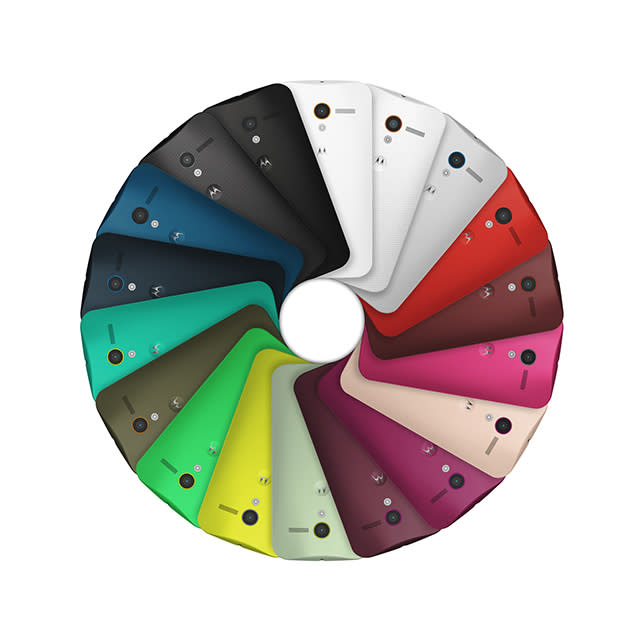 The Right Click
The Right ClickMoto X is here in Canada: What you need to know about this feature-packed smartphone

The highly-anticipated Moto X is being rolled out across Canada this week, days ahead of the big AT&T U.S. launch. While we won’t necessarily have all the same options that are being offered exclusively through AT&T, like Moto Maker and Motorola Skip, there’s still lots to pique the interest of Android fans looking for a phone packed with Google-flavoured features.
In an interview with Yahoo! Canada News, Odile Guinot, Vice President of Sales and General Manager for Mortorola Mobility Canada explained that the Moto X is the physical manifestation of the new relationship between Motorola and Google. It’s been about two years since Motorola was purchased by Google, and after reducing the size of Motorola’s workforce and blending teams from both companies, Guinot says that the result is this user-first phone.
[ Related: Android users finally get feature long used by Apple users: tracking a lost phone ]
“We took the approach of first understanding the consumer,” said Guinot. “We really wanted to design things because it answered needs, not for the sake of designing things or adding more things inside your phone. The idea wasn’t a ‘spec war,’ it’s not a matter of who could add more functions, it was really about what do you need, how do you use your phone? How does the average user use their phone?
“The phone should be adapting to you.”
The result of this approach is the Moto X, which aims to be simple enough that anyone could pick it up and start using it, while providing enough features to keep power users happy. While Guinot says there are plans for more phones to emerge from the Google-Motorola partnership, the Moto X is intended to satisfy the needs of just about everyone.
To do this, the Moto X has some key features that Motorola believes makes it stand out from the increasingly crowded smartphone market. Here’s a look at some of the key features you’ll find in the Moto X:
Quick Capture
Taking photos using the Moto X has been simplified with what the company is calling its Quick Capture process. To activate the camera on the phone, even while on standby, shake the phone twice (turn your wrist like you were using a screwdriver). The camera program will open, and you can start snapping photos right away. The Moto X doesn’t have a dedicated shutter button; instead, click anywhere on the screen. The interface has been cleaned up so you won’t accidentally click on settings while snapping that photo, but if you need to change anything, just swipe right and you’ll get your settings and various filter options. Likewise, if you want to see your photo gallery, swipe to the left.
OK Google Now
Voice control for phones was made big with Apple’s Siri, and Motorola and Google are seeking to improve on this with OK Google Now. They’ve focused on making the software recognize natural language, so you can ask things like a person, instead of giving instructions to a machine (which you still are… well, whatever). Instead of asking “what is the weather today” or saying “set an alarm for noon,” you can say phrases like “do I need an umbrella today” or “wake me up in 20 minutes,” and the software will figure out what you need. Anyone who has used Google Now or used the answer Google provides to a query at the top of your search results will know the kind of questions that can be answered using OK Google Now – the difference is, of course, you ask them out loud. There are some fantastic possibilities for this, like being able to check measurement conversions while you’re baking, without having to wash your hands before touching your phone.
In addition to web searches, you can also use it to send text messages, emails, place and answer calls or start GPS navigation, all hands free.
Active Display
Motorola aimed to get rid of the generic flashing light alert common to many phones by developing Active Display; you can see when you tap the screen what kind of an alert you have (email, text message etc.), and if you hold the icon, you can see the message and who it’s from. Active Display is designed to minimize the number of times you open your phone for only a few seconds, just to check the time or view a notification. It also seeks to conserve battery power by having a predominantly black screen with minimal pixels illuminated, and is only activated when it detects you’re holding the phone and looking at it.
Motorola Assist
Using the phone’s accelerometer and GPS system, the Moto X can detect when you’re likely in a car, and will ask you if you want to activate Motorola Assist. This feature will automatically switch to hands-free mode when it detects you’re in a vehicle, and optionally play your music from where you left off, too. There are also Motorola Assist options you can set which will silence your phone during meetings, based on your calendar, or while you’re asleep.
[ Related: Google’s instant translation devices could turn science fiction into reality ]
Motorola Connect
Using your Chrome browser, you can check incoming calls and text messages on your phone remotely. Handy for situations when you have your laptop but not your phone, like while you’re on vacation.
I’ll be using the Moto X over the next couple of weeks, and will post my impressions on the device once I’ve had a chance to play with it some more. So far, it seems like a solid phone, and especially well-suited to people who like using their Google products and are inclined towards the Android OS.
Need to know what’s hot in tech? Follow @YRightClick on Twitter!


